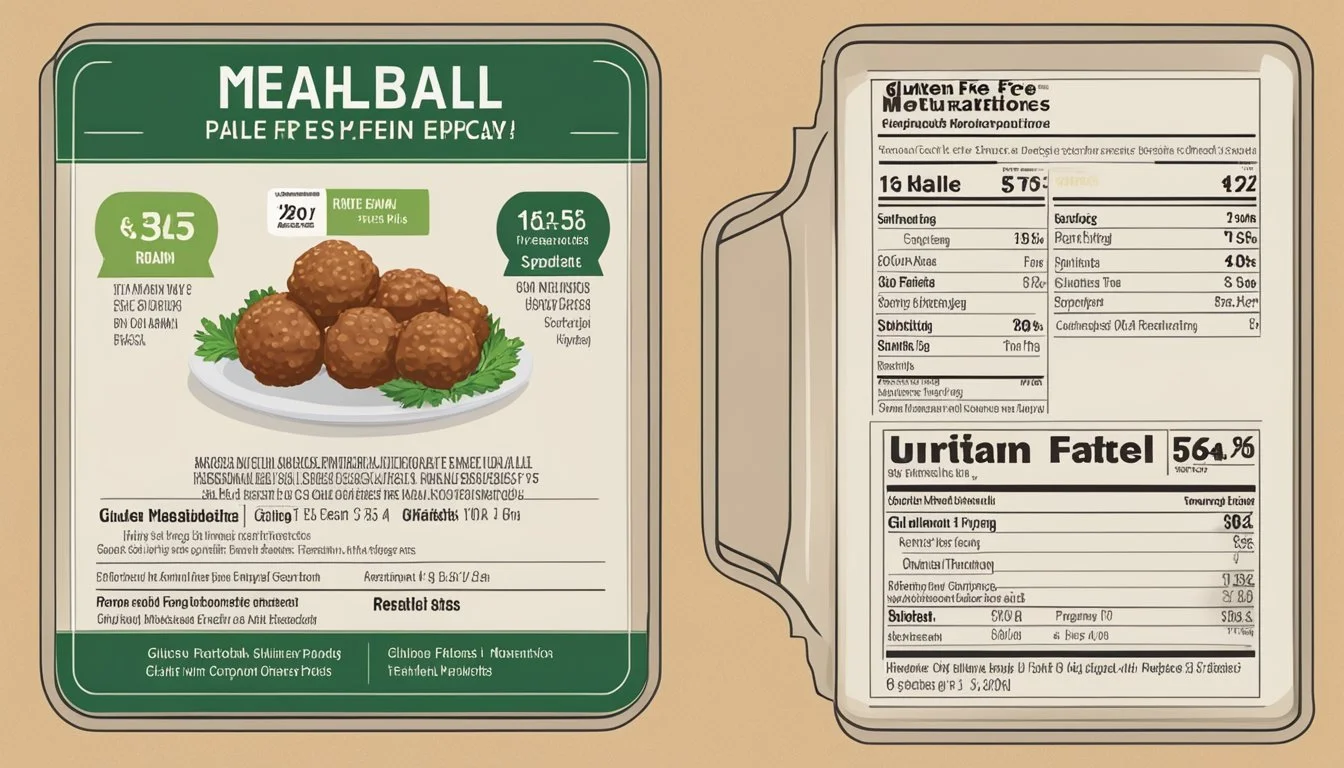How Long Do Gluten-Free Meatballs Last?
Storage Tips and Shelf Life
When it comes to meal prep, understanding the shelf life of gluten-free meatballs is crucial for maintaining freshness and safety. Gluten-free meatballs typically last up to 3-4 days in the refrigerator when stored in an airtight container. This ensures that they remain tender and flavorful while minimizing the risk of spoilage.
Proper storage can extend the longevity of these homemade delicacies. For those who need to keep their meatballs longer, freezing is an effective solution. When frozen, gluten-free meatballs can last up to 3 months without sacrificing taste or texture. Simply place them in a single layer on a baking sheet to freeze initially, then transfer them to a freezer-safe bag.
Ensuring that your gluten-free meatballs remain safe to eat involves paying attention to storage practices and signs of spoilage. Always check for any off smells, discoloration, or changes in texture before consumption. By following these guidelines, you can enjoy delicious gluten-free meatballs whenever you need a quick and comforting meal.
Understanding Gluten-Free Meatballs
Gluten-free meatballs offer a delectable option for those avoiding gluten. They combine essential ingredients to create a flavorful and safe dish that caters to dietary restrictions without compromise.
Defining Gluten-Free
"Gluten-free" means a product contains no gluten, a protein found in wheat, barley, and rye. Gluten causes digestive issues and other symptoms in people with celiac disease or gluten sensitivity. Gluten-free meatballs are crafted without traditional breadcrumbs, using alternatives like gluten-free breadcrumbs or gluten-free bread.
Gluten-Free Meatball Ingredients
Ground beef and ground pork are common base meats, offering a balance of flavor and texture. Gluten-free breadcrumbs, eggs, and aromatic elements like garlic and onion are mixed in. Seasonings such as parsley, Italian seasoning, salt, and black pepper enhance the taste.
Meatballs are formed by combining these ingredients thoroughly. They are then shaped into balls and usually seared or baked until cooked through. This meticulous process ensures that each meatball is flavorful and suitable for those following a gluten-free diet.
Preparation of Gluten-Free Meatballs
Making gluten-free meatballs involves combining seasoned ingredients, forming the mixture into balls, and cooking them using various methods. Each step is essential for achieving the desired taste and texture.
Mixing Ingredients
Start by gathering the required ingredients: gluten-free bread crumbs, ground meat (usually a mix of beef and pork), eggs, milk, and seasonings such as Italian seasoning, onion powder, salt, and garlic.
In a small bowl, combine the gluten-free bread crumbs and milk. Allow the mixture to sit, thickening into a paste consistency. Next, whisk the eggs in another bowl and add them to the breadcrumb mixture. Finally, fold in the ground meat and seasonings, ensuring everything is evenly mixed.
Forming the Meatballs
Once the meat mixture is prepared, the next step is shaping it into meatballs. Using clean hands, scoop out portions of the mixture and roll them into balls approximately 1-2 inches in diameter.
Placing formed meatballs on a baking sheet lined with parchment paper can prevent sticking. Arrange the meatballs in an even layer, ensuring none are touching each other. Proper spacing allows for uniform cooking and browning.
Cooking Options
There are multiple ways to cook gluten-free meatballs, each offering different textures and flavors. One popular method is baking. Preheat the oven to 375°F, then bake meatballs on a lined baking sheet for about 20-25 minutes or until they reach an internal temperature of 165°F.
Alternatively, for a crispier exterior, sear the meatballs on a stovetop. Heat olive oil in a heavy-bottomed skillet over medium-high heat and cook the meatballs for about 2 minutes on each side before transferring them to finish in the oven.
Using an air fryer is another efficient cooking option. Preheat the air fryer to 375°F and cook the meatballs for 10-12 minutes, shaking the basket halfway through to ensure even browning.
Gluten-Free Meatball Variations
Variations in gluten-free meatballs include substituting different types of meat, experimenting with a variety of herbs and spices, and incorporating non-dairy options. These changes can enhance flavor and cater to various dietary needs.
Substituting Meats
Using different types of ground meat can significantly alter the taste and texture of meatballs. Ground turkey and ground chicken are leaner alternatives to beef. They are lower in fat and calories, making them ideal for those seeking a healthier option. Combining meats, like ground pork with ground beef, can offer a richer flavor.
For a more succulent texture, adding olive oil or a small amount of ricotta cheese can keep the meatballs moist. When switching meats, it is crucial to ensure proper binding agents are used to maintain the structure.
Herbs and Spices
Herbs and spices play a pivotal role in defining the flavor profile of meatballs. Including garlic powder and onion powder are basics that provide foundational flavor. Fresh herbs like parsley, oregano, and thyme add brightness.
Red pepper flakes can introduce a slight heat. Using kosher salt instead of regular salt can enhance the flavor without making the meatballs too salty. Experimenting with different seasonings can lead to unique tastes tailored to personal preferences.
Non-Dairy Options
For those avoiding dairy, there are several alternatives to traditional ingredients. Almond flour can replace breadcrumbs to keep meatballs gluten-free while adding a subtle nutty flavor. Non-dairy milk substitutes, such as almond or soy milk, can be used to hydrate the breadcrumbs.
Nutritional yeast is a great substitute for Parmigiano as it offers a cheesy flavor without any dairy. Using these dairy-free options ensures that those with lactose intolerance or dairy allergies can still enjoy delicious meatballs without compromising on taste or texture.
Serving and Pairing Ideas
Gluten-free meatballs can elevate a variety of meals, whether you're planning a hearty dinner or creating a delightful appetizer spread.
Dinner Options
Spaghetti and Meatballs: Gluten-free meatballs pair perfectly with gluten-free spaghetti topped with marinara or tomato sauce. Garnish with fresh basil and parmesan for a comforting and classic meal.
Spaghetti Squash: For a low-carb alternative, serve meatballs over roasted spaghetti squash. This combination provides a satisfying, yet lighter, take on traditional pasta dishes.
Meatball Sub: Place gluten-free meatballs in a gluten-free sub roll, drizzle with marinara sauce, and top with melted mozzarella. This makes a delicious and filling sandwich option.
Lasagna: Incorporate gluten-free meatballs into a gluten-free lasagna. Layer them with gluten-free noodles, ricotta cheese, and marinara sauce for a rich and hearty meal.
Appetizers and Sides
Appetizer Platter: Serve meatballs with toothpicks and a variety of dipping sauces, such as marinara, BBQ sauce, or spicy mustard, as part of an appetizer spread. This setup is great for parties or casual gatherings.
Soup: Add gluten-free meatballs to a vegetable or tomato-based soup for a protein boost. This combination works well for cozy meals on cooler days.
Garlic Bread: Pair gluten-free meatballs with gluten-free garlic bread for a tasty side. The crispy bread complements the tender meatballs and makes for a satisfying bite.
Small Bites: For a sophisticated appetizer, serve mini gluten-free meatballs with a side of marinara sauce for dipping. These bite-sized treats are easy to eat and full of flavor.
These pairing ideas offer versatile options, making gluten-free meatballs a versatile addition to many types of meals.
Storing and Preservation
Proper storage and preservation are essential to ensure gluten-free meatballs remain fresh and safe to eat. The following sections will guide you through the best practices for refrigerating and freezing these meatballs.
Refrigerating Prepared Meatballs
Refrigerated gluten-free meatballs can last up to 3-4 days.
Place the cooked meatballs in an airtight container to prevent them from drying out and absorbing other fridge odors.
If they were served with sauce, store the meatballs and sauce separately to maintain texture.
Label the container with the date to track freshness. Reheat the meatballs thoroughly before consuming to kill any bacteria that may have developed.
Freezing and Thawing
Freezing is an excellent method for longer preservation, extending shelf life up to 3 months.
Arrange the cooked meatballs on a baking sheet lined with parchment paper to freeze individually. Once frozen, transfer them to a freezer-safe bag or container and label with the date.
To thaw, transfer the meatballs to the refrigerator and allow them to defrost overnight. For faster thawing, place the meatballs in a sealed bag and submerge in cold water.
Reheat the meatballs in an oven, stove, or microwave until they reach an internal temperature of 165°F (74°C) for safe consumption.
Safety and Nutritional Information
Proper handling and cooking of gluten-free meatballs ensure both safety and health benefits. It is essential to focus on correct internal cooking temperatures and the wholesome nutritional components that gluten-free options provide.
Internal Cooking Temperature
For food safety, gluten-free meatballs should be cooked to an internal temperature of 165°F (74°C). Using a food thermometer is the most reliable method to check this. Insert the thermometer into the center of the meatball without touching the pan for an accurate reading.
Once cooked to the appropriate temperature, they should be stored in an airtight container. Refrigerate within two hours of cooking to prevent bacterial growth.
Unrefrigerated meatballs should be consumed within two hours. When refrigerated, they remain safe to eat for up to three days. Ensure they are reheated to 165°F (74°C) before consuming again.
Health Benefits of Gluten-Free
Gluten-free meatballs often use ingredients like almond flour or gluten-free breadcrumbs, which can offer additional nutrients. These alternatives typically contain fewer refined grains, which may have health benefits.
Rich in Protein: Gluten-free meatballs often combine beef, pork, or turkey, providing a good source of protein.
Nutrient-Dense Ingredients: Many gluten-free recipes incorporate fresh herbs, vegetables, and healthy fats. This improves the overall nutrient profile, adding vitamins, minerals, and essential amino acids.
Choosing gluten-free options can be beneficial for individuals with gluten intolerances or celiac disease. They avoid the potential digestive issues that gluten can cause and can still enjoy flavorful and satisfying meals.
In summary, ensuring proper cooking and storage of gluten-free meatballs promotes safety. Additionally, these meatballs offer nutritional benefits by including diverse and nutritious ingredients.
Tips for Perfect Gluten-Free Meatballs
To achieve perfect gluten-free meatballs, it is essential to focus on texture and flavor. Key elements include balancing moisture, seasoning, and cooking techniques.
Achieving the Right Texture
Texture is crucial for tender meatballs. Start with a panade, which combines gluten-free breadcrumbs and milk to act as a binder. This helps retain moisture.
Mix the panade with ground meat and allow it to sit, letting the crumbs absorb liquid. An even mix of beef and pork can enhance the texture.
Avoid overmixing—gently combine ingredients to keep meatballs tender. Whether baked or simmered, cooking until just done ensures they stay moist.
Flavor Enhancements
Flavor is vital for satisfying meatballs. Season with a blend of fresh herbs—parsley, oregano, and basil work well.
Adding Worcestershire sauce provides a depth of flavor. Don't forget salt and pepper to taste.
Fresh onion and garlic, sautéed until soft, enhance the overall taste. For added richness, mix in parmesan cheese or red pepper flakes for a touch of heat.
Proper seasoning creates meatballs that are not only gluten-free but also irresistibly flavorful.
Gluten-Free Meatball Recipes
Creating gluten-free meatballs is easier than you think with the right ingredients and techniques. Whether you are looking for a classic recipe or want to try a new twist, there are many delicious and straightforward options.
Classic Gluten-Free Meatball Recipe
A classic gluten-free meatball recipe starts with a combination of ground beef and pork. To ensure the meatballs are tender, prepare a panade by mixing gluten-free bread crumbs with milk and letting it sit until it forms a paste. Combine the meat with seasonings like Italian seasoning, onion powder, and minced garlic.
Form the mixture into balls and either bake on a parchment-lined baking sheet at 375°F for 20-25 minutes or cook in a heavy-bottomed skillet with olive oil. For a slow cooker method, submerge the meatballs in a spaghetti sauce or BBQ sauce and cook on low for 6 hours. This yields a rich, flavorful dish perfect for any easy dinner.
Innovative Meatball Creations
Innovative gluten-free meatball recipes can introduce exciting flavors and ingredients. For instance, swap traditional seasonings for Asian-inspired spices and serve with a soy-free tamari sauce. For a healthier twist, try ground turkey or chicken instead of beef and pork.
Consider adding finely chopped veggies like zucchini or carrots for extra nutrition. For a Swedish twist, prepare a meatball gravy with gluten-free flour and serve with lingonberry sauce. Alternatively, craft BBQ meatballs in a crockpot by using honey BBQ sauce, adding a sweet and savory dimension.
Experimenting with different proteins and sauces can bring new life to your gluten-free meatball repertoire, offering a variety of delicious options tailored to any taste.









